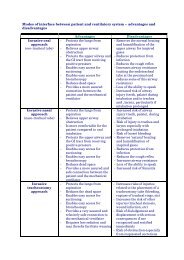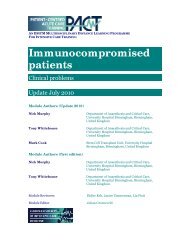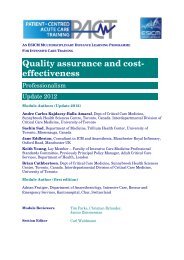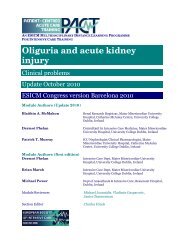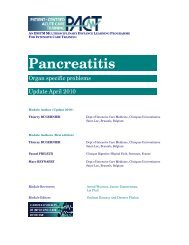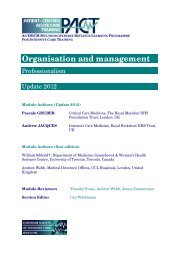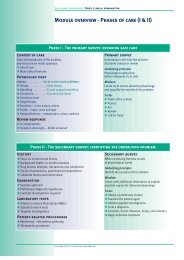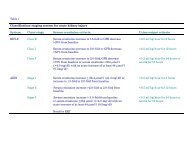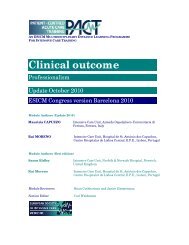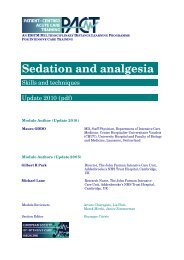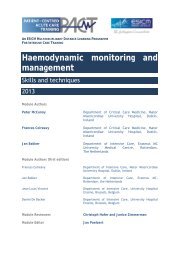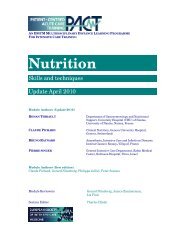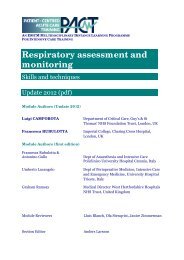Burns injury - PACT - ESICM
Burns injury - PACT - ESICM
Burns injury - PACT - ESICM
You also want an ePaper? Increase the reach of your titles
YUMPU automatically turns print PDFs into web optimized ePapers that Google loves.
Fitzwater J, Purdue GF, Hunt JL, O'Keefe GE. The risk factors and time course<br />
of sepsis and organ dysfunction after burn trauma. J Trauma 2003;<br />
54(5): 959–966. PMID 12777910<br />
Steinvall I, Bak Z, Sjoberg F. Acute respiratory distress syndrome is as<br />
important as inhalation <strong>injury</strong> for the development of respiratory<br />
dysfunction in major burns. <strong>Burns</strong> 2008; 34(4): 441–451. PMID 18243566<br />
Steinvall I, Bak Z, Sjoberg F. Acute kidney <strong>injury</strong> is common, parallels organ<br />
dysfunction or failure, and carries appreciable mortality in patients with<br />
major burns: a prospective exploratory cohort study. Crit Care 2008;<br />
12(5): R124. PMID 18847465<br />
Bak Z, Sjoberg F, Eriksson O, Steinvall I, Janerot-Sjoberg B. Cardiac dysfunction<br />
after burns. <strong>Burns</strong> 2008; 34(5): 603–609. PMID 18378089<br />
Steinvall I, Fredrikson M, Bak Z, Sjoberg F. Mortality after thermal <strong>injury</strong>: no<br />
sex-related difference. J Trauma 2011; 70(4): 959–964. PMID 20693914<br />
Analgesia, sedation and delirium<br />
Also read the <strong>PACT</strong> module on Sedation and Analgesia.<br />
Pain – General aspects<br />
Pain is a major concern in patients with burn <strong>injury</strong>, and both adults and children<br />
experience tachyphylaxis to opioids. This effect is most evident in patients on the<br />
ventilator. The need for analgesics varies considerably between patients. In the early<br />
phase, most patients need general anaesthesia during dressing changes (see<br />
Perioperative management section below on general anaesthesia) due to otherwise<br />
unbearable pain and anxiety. However, burn wounds heal and over time the need for<br />
analgesics decreases as the general condition of the patient improves. To avoid<br />
complications associated with opiate and benzodiazepine withdrawal, most burn<br />
patients need weaning from medication rather than abrupt cessation. A significant<br />
number of burn patients have pre-existing addiction problems. Long-standing<br />
addiction issues may impact on their analgesic requirements and increase the<br />
likelihood of withdrawal problems.<br />
Treatment - Clinical aspects<br />
1. In non-ventilated patients: Combine peripheral and centrally acting<br />
analgesics. Start by combining paracetamol (10–15 mg/kg) given four times<br />
daily (QID) with morphine – starting with low dosage and titrate to effect.<br />
Different formulations of paracetamol are available, the preferred being by<br />
the oral/enteral route. Very large doses of morphine (>100 mg/24hrs) even in<br />
small children might be needed. When the opioid dose is stable, preferably<br />
use long acting drugs. Alternatives to morphine are oxycodone, ketobemidon<br />
and alfentanil. Usually intermittent injections and not infusions are used in<br />
spontaneously breathing patients due to the risk of respiratory depression.<br />
Both in children and adults one can use morphine infusion, 10-30 µg/kg/hr in<br />
spontaneously breathing patients – always monitor to avoid respiratory<br />
depression.<br />
2. In ventilator dependent patients: For short-term sedation, propofol may be<br />
used (maximum dose 4 mg/kg/hr) combined with an opioid (morphine,<br />
fentanyl, alfentanyl, remifentanil). For long-term sedation, midazolam in<br />
combination with an opioid (morphine, fentanyl, alfentanyl, remifentanil,<br />
34



